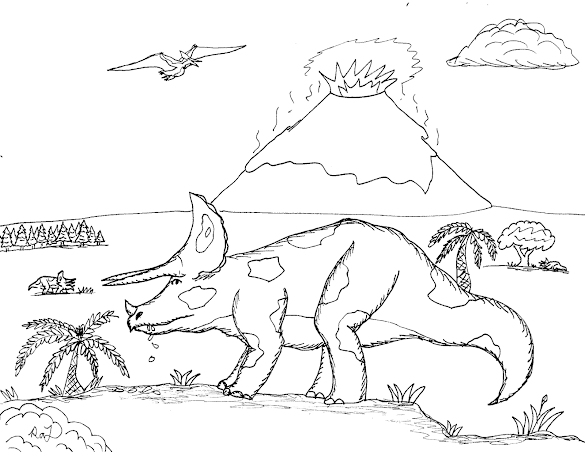Welcome to my free coloring pages blog.
Today's new drawing is of several fauna or animals of the Late Cretaceous, including with
a Tyrannosaurus rex in the foreground.
T. rex with Pteranodons, Triceratops, & a Didelphodon vorax
This drawing features a Tyrannosaurus rex in its prime. T. rex was one of the largest land carnivores ever to live on the Earth. It was the largest carnivore to ever live in North America. It was around 40-44 feet long. That is over 13 meters long. It had a bite force of up to 12,000 lbs. it could and did crush bone. I have a piece of Tyrannosaur coprolite that has pieces of bone in it. Coprolite is fossilized dung. T. rex fossils have been found in many states of the USA including Montana, Texas, Utah, Wyoming, South Dakota, and footprints from a T. rex were found in New Mexico... and fossilized bones of T. rex were also found in 2 providences of Canada (Alberta and Saskatchewan). Other smaller but related Tyrannosaur species have been found in some of these states as well. A similar-sized Tyrannosaur-like Theropod dinosaur lived in China. The biggest T. rex found so far is estimated to have weighed around 19,500 lbs. or almost 8,500 kg. If you look at the oval-like shapes or indentations of the skull you should know that these are fenestra or holes in the skull that helped keep the skull light. T. rex had a huge head and these fenestras or holes to keep the skull lighter was an evolutionary trait in the Theropod dinosaurs. The name Tyrannosaurus rex means Tyrant Lizard King.
In the foreground is a surprise find of Didelphodon vorax. The discovery of Didelphodon vorax rewrote the book on the nature of Cretaceous Period mammals. It was not tiny like a mouse or a rat. It was around 3 feet or maybe around a meter long. It was about the size of a modern opossum. It had a tremendous bite force in its own right. It was an omnivore that ate shellfish, smaller mammals, and plants. Its fossils were found in the USA state of Montana... so it was a contemporary of T. rex in North America. The name Didelphodon vorax means Two Womb Tooth. It was actually a pouched animal... a marsupial like opossums and kangaroos.
Triceratops was a large armored herbivore. It had brow horns as long as broom handles. The dinosaur was around 30 feet long. It clearly had the horns for defense from T. rex. . . but also probably for sexual display and species identification. It actually had three horns. The name Triceratops means Three Horned Face. Triceratops was the largest of all the many Ceratopsian or horned dinosaurs. It weighed up to 26,000 lbs or almost 11,800 kg. Some research by Dr. John Horner has led to a conclusion that when a Triceratops was younger its brow horns pointed kind of up at an angle. Then when it was fully mature its horns curved forward like a modern bovine bull.
The Pterosaurs in this drawing of the Cretaceous Period are the very common at the time Pteranodon. It had a wingspan of up to 18 feet. It had no teeth and it was a piscivore or fish eater. The name Pteranodon means winged, with no teeth or no tooth. Pterosaurs were NOT flying dinosaurs. They were flying reptiles. Pteranodons had a long crest and thin bat-like wings. The wings were not shaped like bat wings, but they were made of very thin membranes. The wings were supported by long arms and one enormously elongated finger. Pteranodon fossils have been found in Kansas (in the USA), England, and Europe. So it must have been pretty common to have such a wide range.
Fairly new research has shown that some Cretaceous dinosaurs ate at least five species of grass. The three species of grass seeds were found in herbivorous dinosaur coprolites. This coprolite was from Hadrosaurs or duck-billed dinosaurs. I did not include a duck-billed dinosaur in this drawing but I wish I had. Hadrosaurs were very common in the Cretaceous Period. The flowers on the bushes are also a rather new discovery. We now know that flowering plants may have first appeared even BEFORE the Cretaceous Period. It was previously thought that flowering plants first occurred at the very end of the Cretaceous Period or maybe in the Tertiary Period. BTW the Tertiary Period is now replaced by two periods that are called the Paleogene Period and Neogene Period.
NOTE: The printable version of this drawing is found by clicking on the button labeled "Paleontology" and then scrolling down to the bottom of the Mesozoic Life section. Have fun coloring! Below are a few other drawings from older posts. All these are of Cretaceous Period animals that are mentioned here or that are in the drawing. These are older drawings so they are found, in printable form, further up the list of printable "Paleontology" drawings.
Pteranodon Fishing
(This drawing was done several years ago.)
Triceratops feeding on Ferns near a Volcano
T. rex drawing from Skull
Tyrannosaurus rex vs Didelphodon vorax
(Edmontosaurus was a large duck-billed dinosaur. This is a size comparison drawing.)
Triceratops Adult with forward facing Horns









No comments:
Post a Comment